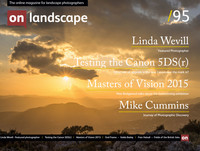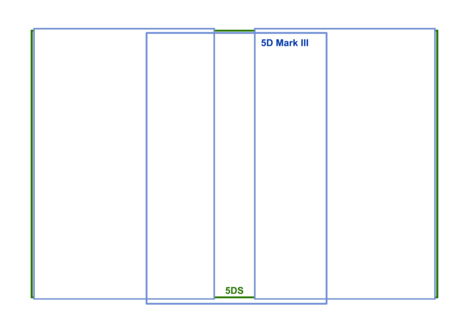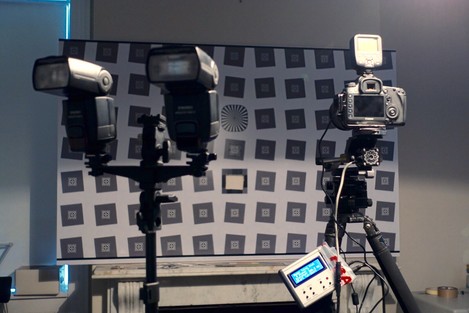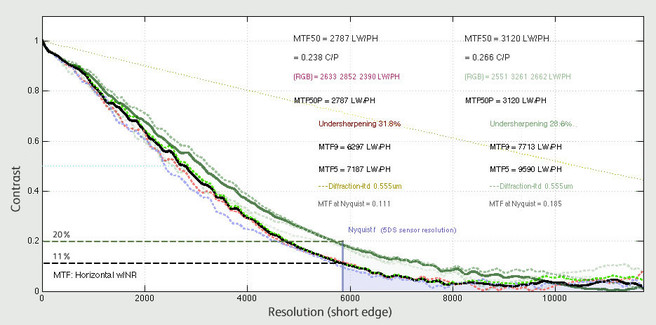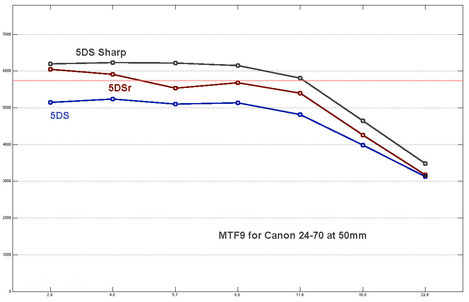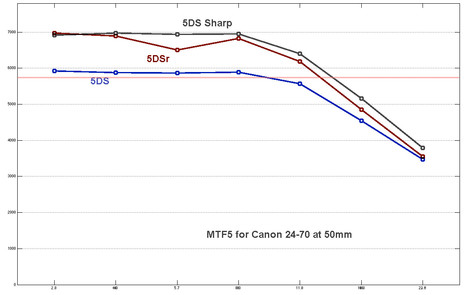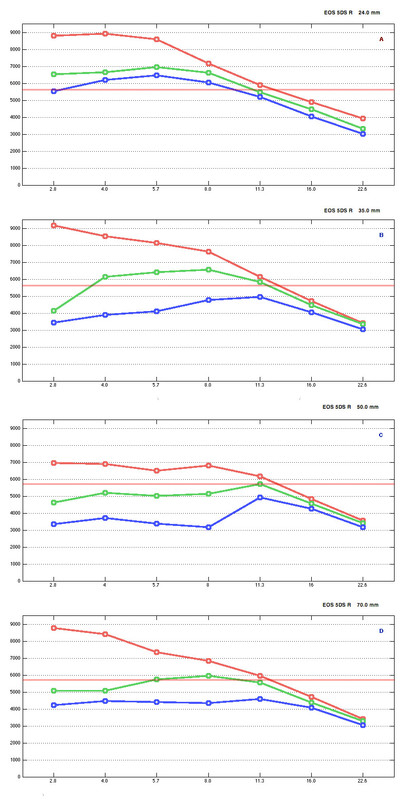What sort of Upgrade is the new Canon over the Mark III?

Tim Parkin
Amateur Photographer who plays with big cameras and film when in between digital photographs.
Ever since the Canon 5D Mark III was released, photographers have been crying out for more resolution, especially when competitors had jumped from 24mp to 36mp, with even higher counts on the horizon. Rumours of a 50mp+ Canon camera surfaced once every few months but nothing solid appeared. However, at the start of 2015, the rumour mill started grinding away again in earnest with reports of a possible 50mp 5D camera.
For a change, this rumour proved to be true. The new Canon 5DS and 5DSr have just over 50 megapixels in a body with various improvements to help handle all those extra pixels. If you want to read some more about the camera, take a look at the following couple of articles we wrote about them after having seen the sample model and having had a chance to talk to Canon directly.
https://www.onlandscape.co.uk/2015/02/5ds-5dsr/
https://www.onlandscape.co.uk/2015/03/resolution/
To put the resolution in perspective in another way, have a look at the diagram below. The 5DS file is the equivalent of a three upright photos from a 5D3 stitched together (with your typical 30% overlap).
More recently, Canon provided me with both the 5DS and the 5DSr and a bunch of lenses (16-35 f/4 IS, 24-70 f/2.8, 24 f/2.8) with which I was to do some in-depth testing.
Since then the Canon has been launched, a little earlier than expected. (although availability has been variable) and there has already been a lot of general talk about the camera so I’m going to cut to the chase and skip general descriptions of features etc.
My goal was to assess the camera in general and to compare the resolution of the camera against the Canon 5D3 and to look at these questions
- Compare the 5DS and 5DSr
- Examine Canon’s recent lenses to see if they can cope with 50.6 megapixels
- Look at the advantage of more resolution when down-sampled to 5D Mark III sizes
- Examine the differences between the 5DS and the 5D3 in terms of colour (real world photography).
"Imatest"
Imatest is an industry standard testing package for lenses and cameras. I should acknowledge the great support and generosity of Norman Koren of Imatest at this point as well!There will be more about my testing setup in another article but for now I’ll explain the results as we go.
Comparing the 5DS and the 5DSr
"How many pixels?!"
Imatest is pretty clever in that it analyses a sloping line to work out the resolution of a sensor. Because this sloping line cuts through pixels at different points (some will be at the very edge of a pixel, others in the middle, etc.) then it can work out the resolution of the lens beyond the resolution of the sensor. It can do this because it 'knows' the edge should be straight and hence uses this fact to interpolate between all the different pixels that cross it.The 5DS gave 6000px as the at MTF9 (9% contrast) and 5DSr gave 7500px at 9% contrast. Both of these figures are over the 5791 pixels that the sensor height for the 5DS(r) gives and hence we’re easily resolving individual pixels in both. . However, the 5DSr will be resolving these pixels with more contrast. How much contrast? Well we took an individual test edge from the imatest target and plotted the contrast vs resolution figures which you can see below.
You can see here that the 5DSr has almost double the contrast at the full resolution of the camera (the blue 'nyquist' line) but that contrast advantage drops as the resolution falls.
But let’s look at this another way. All of those numbers are just looking at the contrast of the pixels. We can increase the contrast by sharpening - and we often do. For the next test I sharpened the 5DS files to a visual match the 5DSr files at the centre of the f/4 image (I used Lightroom sharpening with the detail very low and a 0.6px radius). As you can see from the graph below, the 5DS now matches the 5DSr at f/2.8 to approx f/5.6. Now the 5DS exceeds the 5DSr at smaller apertures.
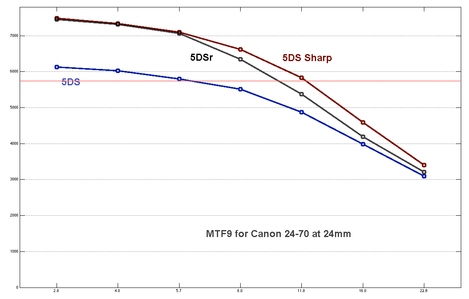 This tells us that the level of sharpening is having a bigger influence on the results here than whether we have an anti-alias filter or not. Obviously sharpening can come with the downside of increased noise and it is up to the purchaser to decide whether the extra noise is counterbalanced by less moiré. I didn't sharpen the 5DSr file at all for this but I could have done so - at that point though it would have ended up a toss-up as to which sensor resolved more.
This tells us that the level of sharpening is having a bigger influence on the results here than whether we have an anti-alias filter or not. Obviously sharpening can come with the downside of increased noise and it is up to the purchaser to decide whether the extra noise is counterbalanced by less moiré. I didn't sharpen the 5DSr file at all for this but I could have done so - at that point though it would have ended up a toss-up as to which sensor resolved more.
Now this test was made on a lens that out resolved the sensor by a reasonable margin. Perhaps a lower resolution lens would make a difference (my guess is not because of the f/16 and f/22 results above)
What we should do now is to find a lens/aperture combination that just resolves the full resolution of the sensor on the 5DSr and see what the results look like on the 5DS. I’ve chosen to use the figures for the 24-70 at 50mm. As you can see, the unsharpened MTF9 image results in under the 5792 pixels of the 5DS.
You can see from the graph here that the 5DSr continues to have a reasonable advantage but optimum sharpening still improves the 5DS files to match.In this case I overshot with the 5DS sharpening slightly but it proves that you can sharpen the image even if there is detail below MTF9 (9% contrast).
In fact I took a look at the MTF 5 (5% contrast) figures and these gave a pretty accurate account of the limit of resolution for sharpening.
What we can infer from this chart is that for the 24-70, you can get away with shooting at f/11 to f/16 with very little affect from diffraction in the center of the image. Counterintuitive after everything you’ve been told about diffraction I know! The main downside of shooting at these smaller apertures is reduced contrast, not reduced resolution.
How do Canon’s recent lenses stand up to 50mp?
The first question you should ask yourself if you want an answer to this question is “What do you expect?”. If you expect absolute pixel perfect sharpness you have quite a challenge - every camera drops resolution (e.g. Bayer array at least) and every lens reduces contrast to some extent.
You could say you’re expecting Zeiss Otus sharpness but at the moment very little matches that - prepare to be disappointed. So what should you expect?
I’ve tried here to create a definition for you. My definition is based on the detail that I can visually see in an image. I’ve compared many test images shot for Imatest testing and worked out whereabouts I think the quality has fallen to a point where I couldn't sharpen things up to a level that is acceptable for printing. This is the point at which pixel level detail is completely missing. Fortunately this corresponds quite closely to the MTF5 values mentioned previously.
So we'll start by looking at the MTF 5 figures for the Canon 24-70 f/2.8 v2. The red line is centre performance, green is edge and the blue is corner. I've added a light red line to the charts to show the native resolution of the 5DS(r) sensor.
Don’t get too obsessed with the fine details of the slope of the curves, you’d be hard pressed to see 10% differences on the screen and the variation between individual copies of the lenses can be as much as that also.
However this does tell us that for a quality zoom lens like the 24-70 f/2.8 v2 we should expect it to keep up with the resolution of the camera in the centre and approach this resolution in the corners once stopped down to f/8 to f/11.
- Sony A7Rii compared with Sony A7R & Canon 5DSr
- Dynamic Range Testing - Sony A7Rii - more testing and discussion
- Sony A7RII – Wrap Up

